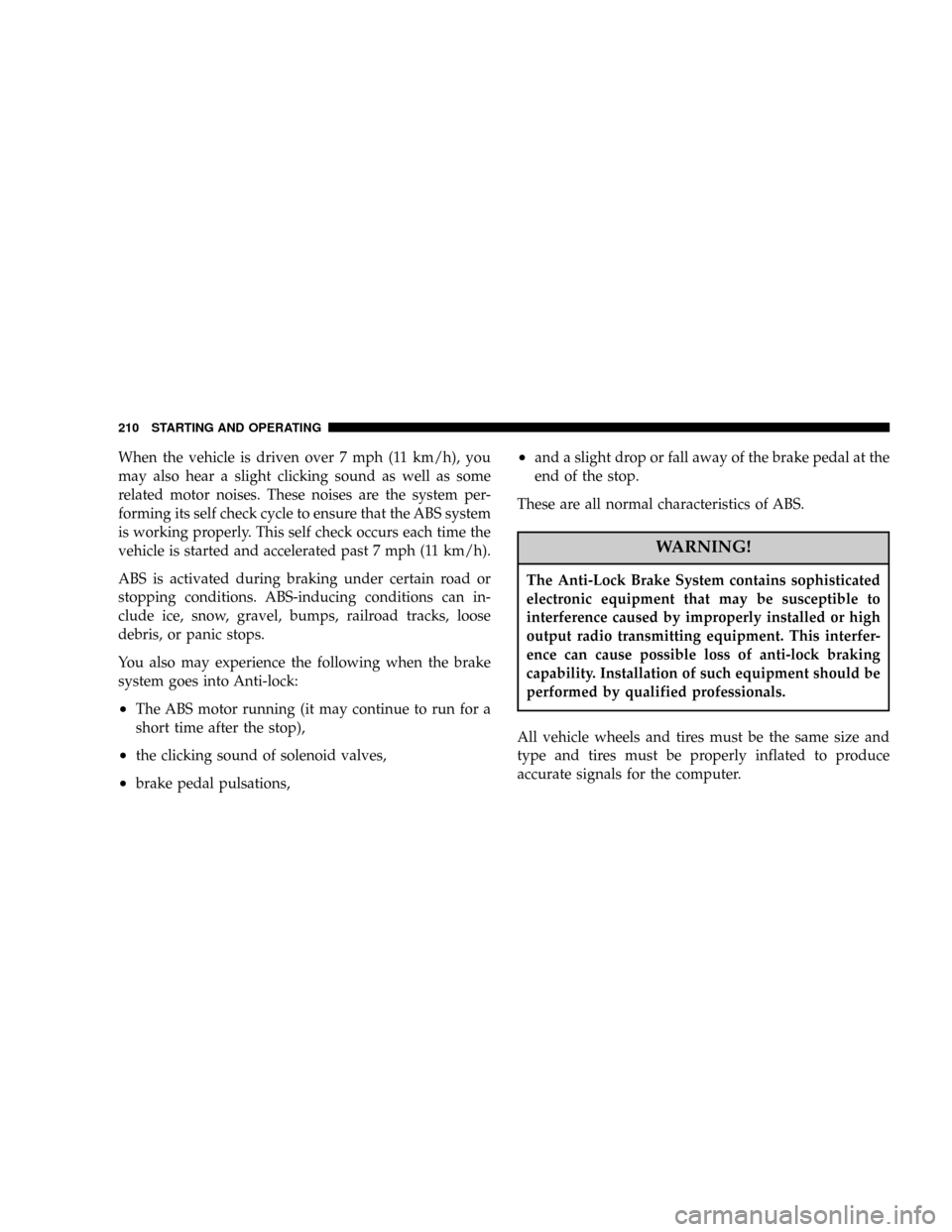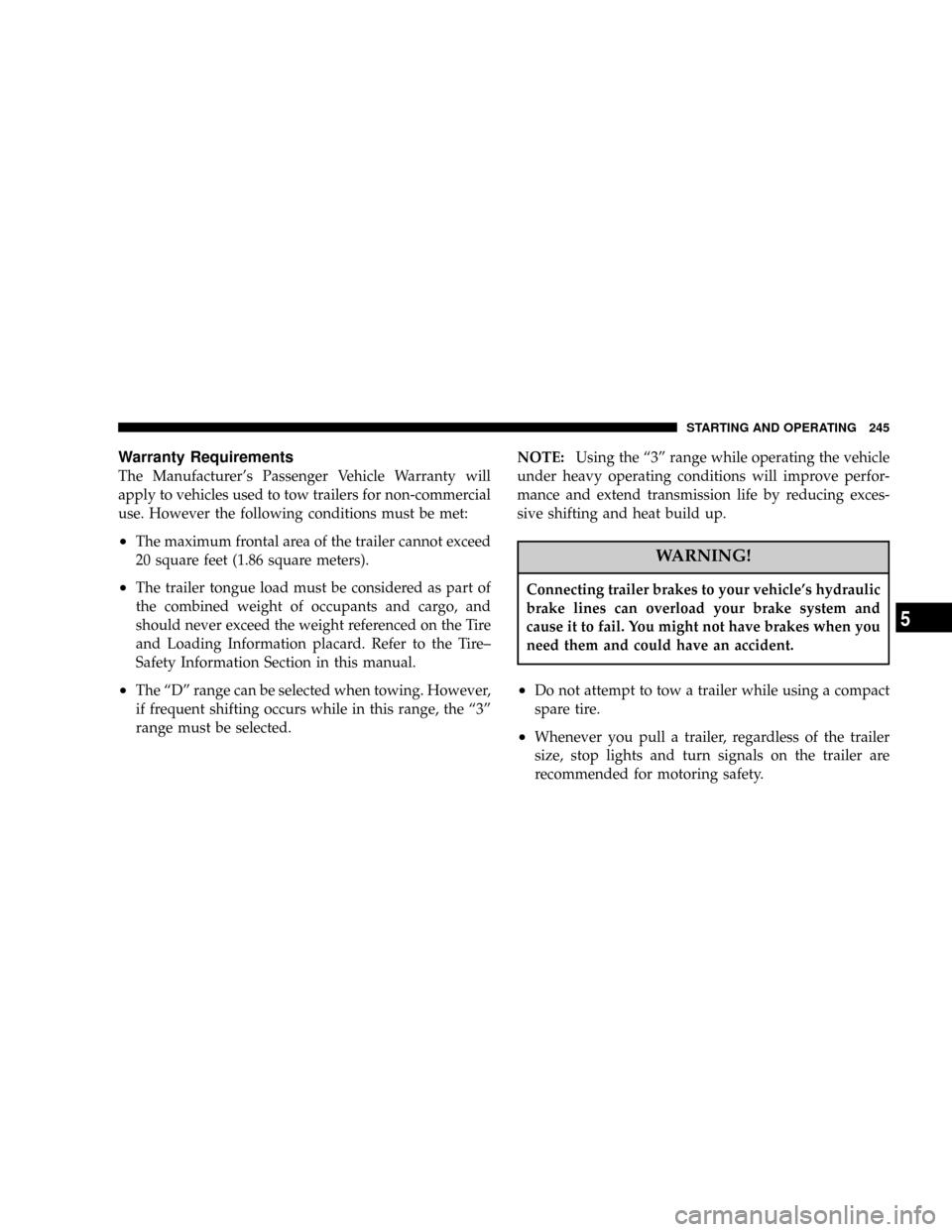Page 209 of 361

WARNING!
²Anti-lock system (ABS) cannot prevent the natu-
ral laws of physics from acting on the vehicle, nor
can it increase braking or steering efficiency be-
yond that afforded by the condition of the vehicle
brakes and tires or the traction afforded.
²The ABS cannot prevent accidents, including
those resulting from excessive speed in turns,
following another vehicle too closely, or hydro-
planing. Only a safe, attentive, and skillful driver
can prevent accidents.
²The capabilities of an ABS equipped vehicle must
never be exploited in a reckless or dangerous
manner which could jeopardize the user's safety
or the safety of others.
The ABS light monitors the Anti-Lock Brake Sys-
tem. The light will come on when the ignition
switch is turned to the ON position and may stay on for
as long as four seconds.
If the ABS light remains on or comes on while driving, it
indicates that the Anti-Lock portion of the brake system
is not functioning and that service is required. However,
the conventional brake system will continue to operate
normally if the BRAKE warning light is not on.
If the ABS light is on, the brake system should be serviced
as soon as possible to restore the benefits of Anti-Lock
brakes. If the ABS light does not come on when the
Ignition switch is turned to the ON position, have the
bulb repaired as soon as possible.
If both the Brake Warning Light and the ABS Light
remain on, the Anti-Lock brakes (ABS) and Electronic
Brake Force Distribution (EBD) systems are not function-
ing. Immediate repair to the ABS system is required.
STARTING AND OPERATING 209
5
Page 210 of 361

When the vehicle is driven over 7 mph (11 km/h), you
may also hear a slight clicking sound as well as some
related motor noises. These noises are the system per-
forming its self check cycle to ensure that the ABS system
is working properly. This self check occurs each time the
vehicle is started and accelerated past 7 mph (11 km/h).
ABS is activated during braking under certain road or
stopping conditions. ABS-inducing conditions can in-
clude ice, snow, gravel, bumps, railroad tracks, loose
debris, or panic stops.
You also may experience the following when the brake
system goes into Anti-lock:
²The ABS motor running (it may continue to run for a
short time after the stop),
²the clicking sound of solenoid valves,
²brake pedal pulsations,
²and a slight drop or fall away of the brake pedal at the
end of the stop.
These are all normal characteristics of ABS.
WARNING!
The Anti-Lock Brake System contains sophisticated
electronic equipment that may be susceptible to
interference caused by improperly installed or high
output radio transmitting equipment. This interfer-
ence can cause possible loss of anti-lock braking
capability. Installation of such equipment should be
performed by qualified professionals.
All vehicle wheels and tires must be the same size and
type and tires must be properly inflated to produce
accurate signals for the computer.
210 STARTING AND OPERATING
Page 245 of 361

Warranty Requirements
The Manufacturer's Passenger Vehicle Warranty will
apply to vehicles used to tow trailers for non-commercial
use. However the following conditions must be met:
²The maximum frontal area of the trailer cannot exceed
20 square feet (1.86 square meters).
²The trailer tongue load must be considered as part of
the combined weight of occupants and cargo, and
should never exceed the weight referenced on the Tire
and Loading Information placard. Refer to the Tire±
Safety Information Section in this manual.
²The ªDº range can be selected when towing. However,
if frequent shifting occurs while in this range, the ª3º
range must be selected.NOTE:Using the ª3º range while operating the vehicle
under heavy operating conditions will improve perfor-
mance and extend transmission life by reducing exces-
sive shifting and heat build up.
WARNING!
Connecting trailer brakes to your vehicle's hydraulic
brake lines can overload your brake system and
cause it to fail. You might not have brakes when you
need them and could have an accident.
²Do not attempt to tow a trailer while using a compact
spare tire.
²Whenever you pull a trailer, regardless of the trailer
size, stop lights and turn signals on the trailer are
recommended for motoring safety.
STARTING AND OPERATING 245
5
Page 266 of 361

NSteering Shaft Seal....................283
NSteering Linkage......................283
NDrive Shaft Universal Joints..............283
NBody Lubrication.....................284
NWindshield Wiper Blades................284
NWindshield And Rear Window Washers.....285
NExhaust System......................285
NCooling System.......................286
NHoses And Vacuum/Vapor Harnesses.......291
NBrakes.............................292
NMaster Cylinder Ð ABS Brakes Brake Fluid
Level Check.........................293
NFuel System Hoses....................294NAutomatic Transmission................295
NAll Wheel Drive (AWD) Ð If Equipped.....298
NFront And Rear Wheel Bearings...........300
NAppearance Care And Protection From
Corrosion...........................300
NCleaning The Center Console Cup Holders . . . 304
mIntegrated Power Module (IPM)............305
mVehicle Storage........................306
mReplacement Light Bulbs.................306
mBulb Replacement......................307
NStandard Quad Headlights...............307
NHigh Intensity Discharge Headlights (HID)
Ð If Equipped.......................308
266 MAINTAINING YOUR VEHICLE
Page 293 of 361

NOTE:Inspection of brake hoses should be performed
whenever the brake system is serviced and at every
engine oil change. Inspect hydraulic brake hoses for
surface cracking, scuffing, or worn spots. If there is any
evidence of cracking, scuffing, or worn spots, the hose
should be replaced immediately! Eventual deterioration
of the hose can take place resulting in a possibility of a
burst failure.
WARNING!
Worn brake hoses can burst and cause brake failure.
You could have an accident. If you see any signs of
cracking, scuffing, or worn spots, have the brake
hoses replaced immediately.
Master Cylinder Ð ABS Brakes Brake Fluid Level
Check
The fluid level in the master cylinder should be checked
when performing underhood services, or immediately if
the brake system warning light indicates system failure.
Clean the top of the master cylinder area before removing
the cap. Add fluid to bring the level up to the top of the
ªFULLº mark on the side of the master cylinder reservoir.
Overfilling of fluid is not recommended because it may
cause leaking in the system.
Add enough fluid to bring the level up to the require-
ments described on the brake fluid reservoir. With disc
brakes, fluid level can be expected to fall as the brake
pads wear. However, low fluid level may be caused by a
leak and a checkup may be needed.
MAINTAINING YOUR VEHICLE 293
7
Page 318 of 361
Once a Month
²Check tire pressure and look for unusual wear or
damage.
²Inspect the battery and clean and tighten the terminals
as required.
²Check the fluid levels of coolant bottle, brake master
cylinder and transmission, add as needed.
²Check all lights and all other electrical items for correct
operation.
At Each Oil Change
²Change the engine oil filter.
²Inspect the exhaust system.
²Inspect the brake hoses.
²Inspect the CV joints and front suspension compo-
nents.
²Check the automatic transmission fluid level.
²Check the coolant level, hoses, and clamps.
²Rotate the tires at each oil change interval shown on
Schedule ªAº 6,000 miles (10 000 km) or every other
interval shown on Schedule ªBº 6,000 miles (10 000
km).
318 MAINTENANCE SCHEDULES
8
M
A
I
N
T
E
N
A
N
C
E
S
C
H
E
D
U
L
E
S
Page 346 of 361

Adding Fuel........................... 240
Adding Washer Fluid..................109,285
Additives, Fuel......................... 238
Adjustable Pedals........................ 99
Air Conditioner Maintenance............... 281
Air Conditioning Filter.................192,282
Air Conditioning Refrigerant............... 281
Air Conditioning System................183,281
Air Pressure, Tires....................... 223
Airbag................................ 43
Airbag Deployment....................... 50
Airbag Light.....................47,52,63,145
Airbag Maintenance....................... 52
Airbag, Side............................ 50
Alarm System........................... 24
Alignment and Balance................... 229
All Wheel Drive...................205,230,298
Alterations/Modifications, Vehicle............. 7
Antifreeze Disposal...................... 290Antifreeze (Engine Coolant)..............287,288
Anti-Lock Brake System................... 208
Anti-Lock Warning Light.................. 139
Anti-Theft Security Alarm.................. 24
Appearance Care........................ 300
Auto Down Power Windows................ 31
Automatic Dimming Mirror................. 70
Automatic Door Locks...................17,18
Automatic Headlights.................... 105
Automatic Temperature Control............. 183
Automatic Transaxle...................201,295
Adding Fluid......................... 313
Filter............................... 297
Fluid and Filter Changes................. 297
Fluid Level Check...................... 296
Interlock System....................... 202
Reset Mode.......................... 202
Selection Of Lubricant................295,313
Shifting............................. 203
346 INDEX
Page 347 of 361

Special Additives...................... 298
Autostick........................ 112,203,204
Ball Joints............................. 283
Battery............................... 279
Jump Starting......................... 258
Keyless Transmitter Replacement............ 23
Bearings.............................. 300
Belts, Drive............................ 276
Body Mechanism Lubrication............... 284
B-Pillar Location........................ 218
Brake, Parking.......................... 206
Brake System........................208,292
Anti-Lock........................... 208
Fluid Check.......................293,313
Hoses.............................. 292
Warning Light........................ 140
Brake/Transmission Interlock............... 201
Break-In Recommendations, New Vehicle........ 61Bulb Replacement....................... 307
Bulbs, Light............................ 306
Calibration, Compass..................... 152
Capacities, Fluid........................ 311
Caps, Filler
Fuel................................ 240
Radiator............................ 289
Car Washes............................ 301
Carbon Monoxide Warning................. 239
Cargo Area Cover....................... 127
Cargo Compartment
Luggage Carrier....................... 130
Cargo Tie-Downs........................ 128
Cassette Tape and Player Maintenance......... 180
Cassette Tape Player...................160,164
Catalytic Converter...................... 278
CD Changer......................159,168,170
CD Player..................155,157,160,166,170
INDEX 347
10